|
My Dream Holiday to Scotland
By
Jeanette
Simpson
I was born in the United
States of America, but Scotland is in my blood. For years I had dreamed of
a holiday in Scotland. As I read the history of the country in history
books, novels by Nigel Tranter, and accounts by John Prebble, my heart
quickened with excitement. Several years ago my cousin began researching
the Scottish line of our family and soon discovered our first ancestor to
come from Scotland, Duncan Carmichael, arrived in 1763. He and his family
settled on the Virginia/North Carolina border. My line of the family
descends through his second son, Archibald. After Archibald’s death in
1827, his children and their families went by wagon train to southern
Indiana because they opposed slavery, which was prevalent in the southern
United States. I grew up in Indiana not many miles from where my ancestors
settled. Hoagy Carmichael, the famous songwriter who wrote
"Stardust," "Georgia on My Mind," and "Ole
Buttermilk Sky" among others, was my grandmother’s cousin.
Because of this interest in
our roots, my cousin and I joined Clan Carmichael USA and began to attend
highland games and other Scottish events where we met others of our same
lineage, many new cousins, who were willing to share their research with
us. From the newsletter of the Clan, we learned that the Chief of Clan
Carmichael, who still lives on the family estate in Scotland, had been
hosting an international gathering in Scotland every 3-4 years since 1983.
He was planning to host a Millennium Gathering of the Clan which was said
to be the biggest event yet held. Two years ago we began planning to
attend.
There was so much of
Scotland we wanted to see, so many places of historical interest, castles,
big cities, little villages, and islands. If you check into flights to
Glasgow or Edinburgh, you will find they are fairly high priced. We wanted
to attend the Clan Gathering but also see as much of the rest of Scotland
as we could without having to mortgage the house! Not being very confident
about driving on the left, finding reasonably priced accommodations, and
finding the places we wanted to see, we opted for a package tour arranged
through a travel agent. Having previously traveled on a Globus tour, we
knew we would have the best of everything at a price that wouldn’t break
the bank. There are other tour companies and even other shorter Scottish
tours with Globus, but the 15-day tour we chose had just about everything
we wanted. We could take the tour and be back in Glasgow on the day vans
from the Carmichael estate were scheduled to pick people up from the
airport for the Gathering.
With Globus tours (your
travel agent will have a Globus Europe and Britain travel book), the
airfare, transportation from the airport to your hotel, all luggage
handling, admissions to sites, all breakfasts, most dinners, and ferry
rides are included in the cost. The price depends upon the time of year
you choose to go. We flew to Glasgow on an overnight flight from Chicago,
Illinois, on June 14. We were on the Globus Scottish Highlands and Islands
Tour. The cost of the trip was $2258 plus $96 in taxes per person when two
people traveled together (this is the year 2000 price) plus your airfare
to your city of departure. The places we stopped for lunches – woolen
mills, castles, a distillery – offered soups, sandwiches, salads, and
scones, sometimes heavier fare, for 2-4 pounds depending on what you
wanted. That is about $3-6 US.
I awoke at 3 a.m. on the
day we were to depart. I hadn’t intended to wake so early, but I was so
excited. My dream was about to come true. I was going to see Scotland,
really see and experience Scotland, a place I love. We were supposed to be
able to sleep on the overnight flight but again my excitement was too
great. We were served breakfast on the plane before arriving in Glasgow
around 9:40 a.m.
As we left Customs, the
red-suited Globus tour representative and our tour director, Jim Lemmon,
met us and led us to the lounge where we waited for several more people
from our tour to arrive on other flights. When we had gathered we were
taken outside to board the red and white Globus bus. This was the last
time we had to worry about our luggage. We were driven to Jury’s Hotel.
Our luggage was unloaded and taken to our rooms. We could rest, walk
around the duck pond beside the hotel, or walk to the Botanical Gardens
just up the street. That evening we met in the lounge of the hotel for a
welcome drink and met our traveling companions. We then all went in to
dinner together at the hotel dining room.
The next morning we put our
luggage outside our door and went down for a breakfast buffet before
boarding our coach. Our luggage had been loaded on the coach in the
meantime. Our driver, Brian Troughton, had numbered each piece of luggage
and would be sure everyone’s luggage got on and off the coach for the
rest of the tour.
Out of Glasgow we went, our
tour director pointing out sites all along the way, giving us history and
answering questions anyone had. This first day of touring took us to the
birthplace of Robert Burns, famous Scottish poet, past the bridge over the
River Doon or Brigadoon, on to Gretna Green where we had lunch, visited a
tartan shop, and saw Highland Coos (cows) and belted Galloway cows. We
crossed the border into northern England to tour Carlisle
Castle, at
various times English and other times Scottish, and spent the night at
Weatheral.
The next day saw us walking
along the top of ruins of Hadrian’s Wall, built after a visit by the
Roman Emperor Hadrian in 122 A.D. It stretched for 73 1/2 miles across the
top of England and was intended to keep the "barbarians" from
the north out. After taking morning tea at the Redesdale B&B, stopping
at Jedburgh for a picture of the abbey ruins, then driving on to Melrose
for lunch at a woolen shop, there was time for some pictures of the ruins
of Melrose Abbey. The heart of Robert the Bruce is buried here. We
continued on to Abbotsford, the home of author and patriot Sir Walter
Scott. All of this is in the Borders where so many battles between the
Scots and English took place in centuries past, and where the reivers
raided from one side of the border to the other stealing cattle and
wreaking havoc. In this area was Ettrick Forest where William Wallace
often hid from the English after his skirmishes with them.
We went on to Edinburgh
where we stayed at the Hilton Hotel. There was an optional excursion
offered tonight, a cost above the tour cost, and we signed up for this. We
toured the Royal Yacht Britannia then went to dinner at the
Intercontinental Hotel where we were fed buffet-style in the 200-year-old
dining room. We were back in our room by 8:15 to unwind a bit before going
to bed with a small waterfall on the river outside our window lulling us
to sleep.
 After breakfast the next
morning, a local guide boarded our coach with us, and we were taken on a
city tour of Edinburgh before going to Edinburgh Castle for a tour. I can’t
begin to tell you all the history and intrigue surrounding this castle. We
then drove down the Royal Mile to Holyrood Palace where we also toured and
visited the gift shop. Mary Queen of Scots’ secretary Rizzio was
murdered here. Parliament sometimes met in the old Holyrood (rood means
cross) Abbey next door. Every place you go has a gift shop so be prepared
with spending money. There are some things you just can’t resist, but
the items vary in price from postcards to silver and porcelain. Using a
credit card for purchases will get a better exchange rate for you. When
you are in a city and have a local guide as we did for this morning
excursion, it is customary to tip the guide at the end of the excursion
usually 1-2 pounds or $2-3 US. The afternoon was free for us to explore
the city on our own. We were dropped off at St. Andrew’s Square near the
city center, got lunch on our own, then explored, some to the shops, some
to the art gallery, some to the Royal Mile, some to Princes Street
Gardens. Globus will provide you with a city map. The coach picked us up 3
1/2 hours later and took us back to the hotel. Another optional excursion
was offered tonight; this one was a Scottish evening of music and dance,
and all who attended enjoyed it. A few people chose to remain at the hotel
to rest. This was the evening my aunt, cousin, and I got stuck in the
elevator at the hotel very briefly! We laugh now! After breakfast the next
morning, a local guide boarded our coach with us, and we were taken on a
city tour of Edinburgh before going to Edinburgh Castle for a tour. I can’t
begin to tell you all the history and intrigue surrounding this castle. We
then drove down the Royal Mile to Holyrood Palace where we also toured and
visited the gift shop. Mary Queen of Scots’ secretary Rizzio was
murdered here. Parliament sometimes met in the old Holyrood (rood means
cross) Abbey next door. Every place you go has a gift shop so be prepared
with spending money. There are some things you just can’t resist, but
the items vary in price from postcards to silver and porcelain. Using a
credit card for purchases will get a better exchange rate for you. When
you are in a city and have a local guide as we did for this morning
excursion, it is customary to tip the guide at the end of the excursion
usually 1-2 pounds or $2-3 US. The afternoon was free for us to explore
the city on our own. We were dropped off at St. Andrew’s Square near the
city center, got lunch on our own, then explored, some to the shops, some
to the art gallery, some to the Royal Mile, some to Princes Street
Gardens. Globus will provide you with a city map. The coach picked us up 3
1/2 hours later and took us back to the hotel. Another optional excursion
was offered tonight; this one was a Scottish evening of music and dance,
and all who attended enjoyed it. A few people chose to remain at the hotel
to rest. This was the evening my aunt, cousin, and I got stuck in the
elevator at the hotel very briefly! We laugh now!
 The next day saw us off to
St. Andrew’s, the famous golf course, where we had time to look at the
course, shop for souvenirs, walk to the beach to see where part of the
movie "Chariots of Fire" was filmed, or visit the Museum of
Golf. We drove by Leuchars Air Force Base and stopped to watch jets doing
touch and goes before going on to Glamis Castle, childhood home of the
Queen Mother and birthplace of Princess Margaret. We toured the rooms, had
time to walk the grounds, then had lunch at the castle. They have the best
Leek and Potato Soup, something I learned to love in Scotland. (It was 100
degrees when I got home and I still had to make a big pot of this soup!)
We spent this night at Aberdeen, the center of the North Sea oil business.
Our hotel had two clocks in the lobby – one for local time and one for
the time in Houston, Texas. An optional excursion to Dunottar Castle,
spectacular ruins on the North Sea, was offered this evening along with a
visit to a pub in Stonehaven, a small fishing village nearby. The Honors
of Scotland were hidden in Dunottar Castle, home of the Keiths, at the
time of Oliver Cromwell, this story told in a book by Nigel Tranter
entitled "Honours Even." The next day saw us off to
St. Andrew’s, the famous golf course, where we had time to look at the
course, shop for souvenirs, walk to the beach to see where part of the
movie "Chariots of Fire" was filmed, or visit the Museum of
Golf. We drove by Leuchars Air Force Base and stopped to watch jets doing
touch and goes before going on to Glamis Castle, childhood home of the
Queen Mother and birthplace of Princess Margaret. We toured the rooms, had
time to walk the grounds, then had lunch at the castle. They have the best
Leek and Potato Soup, something I learned to love in Scotland. (It was 100
degrees when I got home and I still had to make a big pot of this soup!)
We spent this night at Aberdeen, the center of the North Sea oil business.
Our hotel had two clocks in the lobby – one for local time and one for
the time in Houston, Texas. An optional excursion to Dunottar Castle,
spectacular ruins on the North Sea, was offered this evening along with a
visit to a pub in Stonehaven, a small fishing village nearby. The Honors
of Scotland were hidden in Dunottar Castle, home of the Keiths, at the
time of Oliver Cromwell, this story told in a book by Nigel Tranter
entitled "Honours Even."
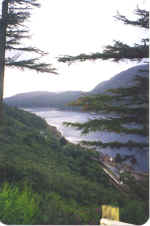 The fog was rolling in off
of the North Sea when we woke the next morning. It was so typically what
one thinks of with Scotland and ‘rolling’ is the correct word. The
first part of our route toward Balmoral Castle, the Queen’s home in the
Highlands, was very foggy, but it soon lifted as we got farther inland. We
toured the ballroom with historic displays at the castle, walked the
grounds, visited the gift shop, then went on to the Glenlivet Distillery
for a tour and lunch in their pleasant restaurant. The majestic scenery
began soon after leaving Glenlivet and the coach driver obligingly stopped
for us to take photos and to point out grouse and oyster catcher birds in
the heather. We reached Culloden and while some went into the visitor
center to watch the film, my cousin and I chose to walk the battlefield.
We could almost hear the noise of that battle and were moved to find the
markers at the various clan burial sites. Some of our Highland Carmichael
ancestors fell as standard bearers for the Stewart of Appin clan. This is
an emotional place. Imagine Bonnie Prince Charlie overlooking this moor as
his Highland supporters died for his cause. Imagine the Butcher Cumberland
and his troops doing their evil deeds. The horror of this place makes one
walk around quietly. This night was spent at the Jarvis Caledonian Hotel
in Inverness. The fog was rolling in off
of the North Sea when we woke the next morning. It was so typically what
one thinks of with Scotland and ‘rolling’ is the correct word. The
first part of our route toward Balmoral Castle, the Queen’s home in the
Highlands, was very foggy, but it soon lifted as we got farther inland. We
toured the ballroom with historic displays at the castle, walked the
grounds, visited the gift shop, then went on to the Glenlivet Distillery
for a tour and lunch in their pleasant restaurant. The majestic scenery
began soon after leaving Glenlivet and the coach driver obligingly stopped
for us to take photos and to point out grouse and oyster catcher birds in
the heather. We reached Culloden and while some went into the visitor
center to watch the film, my cousin and I chose to walk the battlefield.
We could almost hear the noise of that battle and were moved to find the
markers at the various clan burial sites. Some of our Highland Carmichael
ancestors fell as standard bearers for the Stewart of Appin clan. This is
an emotional place. Imagine Bonnie Prince Charlie overlooking this moor as
his Highland supporters died for his cause. Imagine the Butcher Cumberland
and his troops doing their evil deeds. The horror of this place makes one
walk around quietly. This night was spent at the Jarvis Caledonian Hotel
in Inverness.
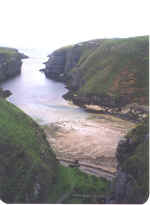 It was rainy as we drove to
Pringle’s Woolen Mill in Inverness the next morning, but somehow one
doesn’t mind the rain in Scotland. Just be sure to take a raincoat and
umbrella with you on the tour. Dunrobin Castle was our next stop, home of
the dukes and earls of Sutherland, not the most beloved people in Scottish
history, especially at the time of the Highland Clearances. We saw a
falconry display here and toured the house and gardens before having
lunch. The fireplace was blazing in the dining room and it felt so good to
take the chill off. The scenery was once again spectacular as we headed
for Wick. The Caithness Glass Factory was our first stop. While we watched
glass being made then shopped in the gift shop, Brian, our driver, took
our bags to the hotel so they would be waiting for us when we arrived. He
did this most days while we were seeing the sites. We stayed at the
Norsemen Hotel. An optional excursion to the Cairns of Camster and to a
small pub in an old blacksmith shop was offered tonight. The burial cairn
was fascinating and the small pub was wonderful with old stone walls and
beamed ceiling. Some locals provided a ceilidh. None of us had ever
dreamed we would be sitting in an old pub in the north of Scotland singing
"Amazing Grace." Back at the hotel we had the most delightful
waiters in the dining room this night. We decided they must serve laughing
water. We were enjoying our companions and the tour so much. It was rainy as we drove to
Pringle’s Woolen Mill in Inverness the next morning, but somehow one
doesn’t mind the rain in Scotland. Just be sure to take a raincoat and
umbrella with you on the tour. Dunrobin Castle was our next stop, home of
the dukes and earls of Sutherland, not the most beloved people in Scottish
history, especially at the time of the Highland Clearances. We saw a
falconry display here and toured the house and gardens before having
lunch. The fireplace was blazing in the dining room and it felt so good to
take the chill off. The scenery was once again spectacular as we headed
for Wick. The Caithness Glass Factory was our first stop. While we watched
glass being made then shopped in the gift shop, Brian, our driver, took
our bags to the hotel so they would be waiting for us when we arrived. He
did this most days while we were seeing the sites. We stayed at the
Norsemen Hotel. An optional excursion to the Cairns of Camster and to a
small pub in an old blacksmith shop was offered tonight. The burial cairn
was fascinating and the small pub was wonderful with old stone walls and
beamed ceiling. Some locals provided a ceilidh. None of us had ever
dreamed we would be sitting in an old pub in the north of Scotland singing
"Amazing Grace." Back at the hotel we had the most delightful
waiters in the dining room this night. We decided they must serve laughing
water. We were enjoying our companions and the tour so much.
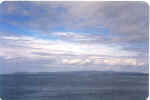 Dunnet Head is at the very
north edge of Scotland. The sea and sky were varying shades of grey, blue,
and lavendar, the colors changing constantly, the quality of the light
beautiful. We took many pictures here the next morning before going to
John O’Groats to board the ferry to the Orkney Islands. Again as we
crossed on the ferry, the skies and water changed and provided opportunity
for wonderful photos. We arrived on South Ronaldsay to be met by a local
coach and went immediately to the Italian Chapel. This chapel was built by
Italian prisoners of war during WWII. The inside is amazing with paintings
on the walls, chandeliers made of carved up meat cans, and many little
details that these men so far from home wanted in their chapel. We then
went to the Ring of Brodgar, a stone circle like Stonehenge, then to Skara
Brae, the ruins of a 5,000-year-old Neolithic settlement. From there we
went to Kirkwall, the Orkney capitol, and had time to shop and visit the
redstone cathedral before catching our ferry back to the mainland. We were
back at our hotel by 6:15 p.m. Dunnet Head is at the very
north edge of Scotland. The sea and sky were varying shades of grey, blue,
and lavendar, the colors changing constantly, the quality of the light
beautiful. We took many pictures here the next morning before going to
John O’Groats to board the ferry to the Orkney Islands. Again as we
crossed on the ferry, the skies and water changed and provided opportunity
for wonderful photos. We arrived on South Ronaldsay to be met by a local
coach and went immediately to the Italian Chapel. This chapel was built by
Italian prisoners of war during WWII. The inside is amazing with paintings
on the walls, chandeliers made of carved up meat cans, and many little
details that these men so far from home wanted in their chapel. We then
went to the Ring of Brodgar, a stone circle like Stonehenge, then to Skara
Brae, the ruins of a 5,000-year-old Neolithic settlement. From there we
went to Kirkwall, the Orkney capitol, and had time to shop and visit the
redstone cathedral before catching our ferry back to the mainland. We were
back at our hotel by 6:15 p.m.
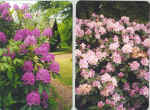 The next day provided the
most glorious, breathtaking scenery we would see on our tour. We followed
a single-track road along the northern coast of Scotland. I can use the
words grand, haunting, beautiful, spectacular, timeless, mysterious –
none of these do justice to what you will see in this part of the tour. I
wanted to throw my arms in the air and twirl around in happiness. It was
chilly today but the air felt so good. It was clean and pure. Around every
corner there was something new about which to sigh in wonder. We had to
pull to the side to let cars pass us; we had to slow down for sheep in the
road. Our driver was excellent throughout the tour. We stopped often for
photos but we made it all the way to Ullapool for a late lunch, which my
cousin, aunt and I chose to eat at a fish and chips shop. Eilean Donan
Castle, a MacKenzie stronghold that was put into the care of MacRaes, gave
us another picture stop along the road. This castle figures prominently in
the history of Scotland. Crossing the bridge to Skye was an expensive trip
for the coach – 43 pounds! We stayed at the Dunollie Hotel in Broadford
that night. I walked around and absorbed the atmosphere. I’ve always
dreamed of going to Skye. Tonight there was live music in the bar where a
fire warmed the room and smiles lit the faces of our tour group. The next day provided the
most glorious, breathtaking scenery we would see on our tour. We followed
a single-track road along the northern coast of Scotland. I can use the
words grand, haunting, beautiful, spectacular, timeless, mysterious –
none of these do justice to what you will see in this part of the tour. I
wanted to throw my arms in the air and twirl around in happiness. It was
chilly today but the air felt so good. It was clean and pure. Around every
corner there was something new about which to sigh in wonder. We had to
pull to the side to let cars pass us; we had to slow down for sheep in the
road. Our driver was excellent throughout the tour. We stopped often for
photos but we made it all the way to Ullapool for a late lunch, which my
cousin, aunt and I chose to eat at a fish and chips shop. Eilean Donan
Castle, a MacKenzie stronghold that was put into the care of MacRaes, gave
us another picture stop along the road. This castle figures prominently in
the history of Scotland. Crossing the bridge to Skye was an expensive trip
for the coach – 43 pounds! We stayed at the Dunollie Hotel in Broadford
that night. I walked around and absorbed the atmosphere. I’ve always
dreamed of going to Skye. Tonight there was live music in the bar where a
fire warmed the room and smiles lit the faces of our tour group.
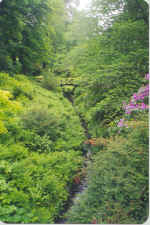 We drove along the Sound of
Sleat to the Clan Donald Centre the next morning. Beauty overload on this
drive. This is where the MacDonalds lived. Donald, grandson of Somerled
who was Lord of the Isles in the 1100s, founded Clan MacDonald. We watched
a film about the clan, photographed the ruins of the castle, walked
through the boggy woods and took pictures of fern glades, interesting
trees, and rhododendrons, which are blooming everywhere in Scotland in
June. The coach could drive on to the ferry from Skye to Mallaig on the
mainland. Most of us stayed on deck to take pictures. We stopped at the
Glenfinnan Monument to take pictures of the spot where Bonnie Prince
Charlie first stepped onto the Scottish mainland from Loch Shiel. We had
lunch at the woolen mill in Fort William. Here I was reminded that the
Campbell troops who murdered the MacDonalds at Glencoe in 1692 were
commanded from Fort William. As we reached the northern end of Loch Linnhe,
we looked across to Glen Coe, the closest we would get to the site of the
massacre on this particular tour. There were seals on the rocks in the
loch. We were driving through Argyll now, Campbell territory. At Lochaline
we took the ferry to Fishnish on the Isle of Mull where we stayed at the
Isle of Mull Hotel at Craignure. We drove along the Sound of
Sleat to the Clan Donald Centre the next morning. Beauty overload on this
drive. This is where the MacDonalds lived. Donald, grandson of Somerled
who was Lord of the Isles in the 1100s, founded Clan MacDonald. We watched
a film about the clan, photographed the ruins of the castle, walked
through the boggy woods and took pictures of fern glades, interesting
trees, and rhododendrons, which are blooming everywhere in Scotland in
June. The coach could drive on to the ferry from Skye to Mallaig on the
mainland. Most of us stayed on deck to take pictures. We stopped at the
Glenfinnan Monument to take pictures of the spot where Bonnie Prince
Charlie first stepped onto the Scottish mainland from Loch Shiel. We had
lunch at the woolen mill in Fort William. Here I was reminded that the
Campbell troops who murdered the MacDonalds at Glencoe in 1692 were
commanded from Fort William. As we reached the northern end of Loch Linnhe,
we looked across to Glen Coe, the closest we would get to the site of the
massacre on this particular tour. There were seals on the rocks in the
loch. We were driving through Argyll now, Campbell territory. At Lochaline
we took the ferry to Fishnish on the Isle of Mull where we stayed at the
Isle of Mull Hotel at Craignure.  The dining room and lobby of this hotel
look out over the water toward the mainland. We walked to the beach before
dinner then after dinner we followed a footpath at the end of the village
that led up into the heather and toward the other side of the island where
we got a different view. A father and son wearing kilts entertained at the
hotel that evening, singing Scottish songs and encouraging all of us to
join in. The dining room and lobby of this hotel
look out over the water toward the mainland. We walked to the beach before
dinner then after dinner we followed a footpath at the end of the village
that led up into the heather and toward the other side of the island where
we got a different view. A father and son wearing kilts entertained at the
hotel that evening, singing Scottish songs and encouraging all of us to
join in.
 There was a little
waterfall hidden along the beach and I was up early the next morning to go
find it. The sun was just peeking through and I took pictures as I walked.
Today we were taken to the ferry dock where we caught the ferry to Iona,
the tiny Holy Island where Columba first brought Christianity to Scotland
from Ireland in 563 A.D.. This island is the burial place of kings
including Kenneth MacAlpin, who united the Scots and Picts and gave us
Scotland in the 800s, Duncan, and MacBeth as well as Irish and Viking
kings. Many times the Norsemen raided here killing monks and destroying
Christian relics. There was a little
waterfall hidden along the beach and I was up early the next morning to go
find it. The sun was just peeking through and I took pictures as I walked.
Today we were taken to the ferry dock where we caught the ferry to Iona,
the tiny Holy Island where Columba first brought Christianity to Scotland
from Ireland in 563 A.D.. This island is the burial place of kings
including Kenneth MacAlpin, who united the Scots and Picts and gave us
Scotland in the 800s, Duncan, and MacBeth as well as Irish and Viking
kings. Many times the Norsemen raided here killing monks and destroying
Christian relics. 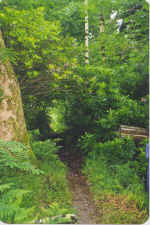 We were here on a Sunday so were able to attend the
church service in the abbey, no longer a Celtic service, of course.
Several of us went into a store and bought sandwiches, chips, and drinks
and sat on the ferry dock to eat. It was sunny and beautiful and the
waters were varying shades of rich blue and green. Someone remarked that a
tropical isle movie could be shot here if some fake palm trees were
brought in. We were here on a Sunday so were able to attend the
church service in the abbey, no longer a Celtic service, of course.
Several of us went into a store and bought sandwiches, chips, and drinks
and sat on the ferry dock to eat. It was sunny and beautiful and the
waters were varying shades of rich blue and green. Someone remarked that a
tropical isle movie could be shot here if some fake palm trees were
brought in.
We rode the ferry back to
Mull where our coach was waiting for us then made a quick stop at the
hotel before going the other direction on the island. At Salen we went
into a silversmith shop belonging to the son who had entertained at the
hotel the night before. He supplies a large percentage of the Celtic
crosses sold worldwide and makes the ones sold at the abbey on Iona. He
gave us a shop discount. We then went on to the colorful seaside village
of Tobermory. A recent book I read had Somerled, Lord of the Isles,
driving the Norsemen from this part of the island. I tried to imagine the
dragon ships moored in the harbor.
 After dinner we spent more
time at the beach just sitting on rocks and enjoying the peace of the
place. If we looked off to the north, we could see the Isle of Lismore
where our ancestor Duncan was born in 1730. He was alive when the Battle
of Culloden was fought. He was alive when the Highland Clearances were
taking place. Is that why he left Scotland? How did these events shape his
life? His grandfather probably remembered the Massacre of Glencoe. What
did he tell his children and grandchildren about that? And what values and
traditions do I have today that came from lessons learned during these
difficult times? After dinner we spent more
time at the beach just sitting on rocks and enjoying the peace of the
place. If we looked off to the north, we could see the Isle of Lismore
where our ancestor Duncan was born in 1730. He was alive when the Battle
of Culloden was fought. He was alive when the Highland Clearances were
taking place. Is that why he left Scotland? How did these events shape his
life? His grandfather probably remembered the Massacre of Glencoe. What
did he tell his children and grandchildren about that? And what values and
traditions do I have today that came from lessons learned during these
difficult times?
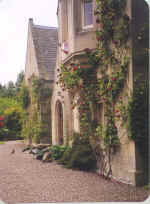 Early the next morning we
boarded the ferry from Craignure, Mull, to Oban on the mainland. The
MacLean stronghold of Castle Duart was on our right as we crossed with
Lismore Isle being on our left. Back on the coach we headed for Loch
Lomond and a picture stop before going to Inverary to shop or have tea at
the woolen mill with time to walk to the castle or sit on a bench and
relax in the scenery. We arrived in Glasgow during the early afternoon and
toured the Museum of Transport where we had lunch. We then had an overall
tour of the city with major sites pointed out to us before heading to our
hotel. There was an optional dinner excursion offered tonight. Early the next morning we
boarded the ferry from Craignure, Mull, to Oban on the mainland. The
MacLean stronghold of Castle Duart was on our right as we crossed with
Lismore Isle being on our left. Back on the coach we headed for Loch
Lomond and a picture stop before going to Inverary to shop or have tea at
the woolen mill with time to walk to the castle or sit on a bench and
relax in the scenery. We arrived in Glasgow during the early afternoon and
toured the Museum of Transport where we had lunch. We then had an overall
tour of the city with major sites pointed out to us before heading to our
hotel. There was an optional dinner excursion offered tonight.
Our final tour day took us
to Stirling of Braveheart fame. We stopped to take pictures of the castle,
could see the Wallace Monument in the distance, and knew that Stirling
Bridge, the site of his famous victory was nearby. At Bannockburn, we
walked onto the battlefield to see the statue of Robert Bruce, King Robert
I, who defeated the English here in 1314 to win independence for Scotland,
at least for a few years. The Scottish Woolen Centre at Aberfoyle provided
us with an interesting sheep show, a large woolen store, and a place to
have lunch. It was a lovely sunny day so we could eat at tables outside.
The afternoon was free for shopping in Glasgow then there was a farewell
dinner that night at the Thistle Hotel where we were staying. At this
event each person on the tour gave a tip to the guide and driver, the
suggested amount being $2-5 per day so that is another thing you should
plan for when you take the trip.
 Our Globus tour director
and coach driver transported us to Glasgow Airport the next morning. It
was very hard to say goodbye to the other people on our tour. There were
38 of us and we had become a family and learned so much about one another
and our roots. There were people from England, Australia, New Zealand,
Canada, and the US on this tour. There was something of interest to
everyone. Every person expressed appreciation of it. I would recommend it
highly to anyone. In fact, I plan to take it again some August when the
heather is in bloom. Our Globus tour director
and coach driver transported us to Glasgow Airport the next morning. It
was very hard to say goodbye to the other people on our tour. There were
38 of us and we had become a family and learned so much about one another
and our roots. There were people from England, Australia, New Zealand,
Canada, and the US on this tour. There was something of interest to
everyone. Every person expressed appreciation of it. I would recommend it
highly to anyone. In fact, I plan to take it again some August when the
heather is in bloom.
 My cousin, aunt and I
waited at the airport to be picked up by a van from the Carmichael estate.
We still had our Clan Carmichael Millennium Gathering to attend. The van
did arrive and we were taken 40 minutes southeast into Lanarkshire and the
Wyndales House Hotel, with its oak paneling, leaded glass windows, and
everything you would envision when thinking of a manor house. The staff
treated us royally. We met other Carmichaels there. That evening, we were
driven to the Tinto Hotel in Symington, a larger hotel where many more
Carmichaels were staying. We had a welcoming dinner here with the
Carmichael Chief, Richard Carmichael of Carmichael, greeting us as we
arrived. My cousin, aunt and I
waited at the airport to be picked up by a van from the Carmichael estate.
We still had our Clan Carmichael Millennium Gathering to attend. The van
did arrive and we were taken 40 minutes southeast into Lanarkshire and the
Wyndales House Hotel, with its oak paneling, leaded glass windows, and
everything you would envision when thinking of a manor house. The staff
treated us royally. We met other Carmichaels there. That evening, we were
driven to the Tinto Hotel in Symington, a larger hotel where many more
Carmichaels were staying. We had a welcoming dinner here with the
Carmichael Chief, Richard Carmichael of Carmichael, greeting us as we
arrived.
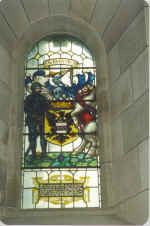 The next day he had tours
arranged around the estate to show us the historic sites – the hill fort
(caer) where the original church, which Queen Margaret dedicated to St.
Michael, had stood and from which we got our name of Carmichael, the
mansion house built in the 1700s by the Great Earl of Hyndford, and the
current Chief’s home. Various cottages on the estate are rented out to
holidaymakers, and many of our Carmichael cousins were staying in them for
the Gathering. There is a Discover Carmichael Centre with a gift shop, wax
museum of historic figures, and a restaurant where we had our lunch.
Tonight we were treated to a murder mystery dinner at the hotel. The next day he had tours
arranged around the estate to show us the historic sites – the hill fort
(caer) where the original church, which Queen Margaret dedicated to St.
Michael, had stood and from which we got our name of Carmichael, the
mansion house built in the 1700s by the Great Earl of Hyndford, and the
current Chief’s home. Various cottages on the estate are rented out to
holidaymakers, and many of our Carmichael cousins were staying in them for
the Gathering. There is a Discover Carmichael Centre with a gift shop, wax
museum of historic figures, and a restaurant where we had our lunch.
Tonight we were treated to a murder mystery dinner at the hotel.
The following day three
coach loads of Carmichaels went to Jedburgh to see the abbey ruins, the
Mary Queen of Scots House (one of our ancestors was mistress to James V
and bore him children who were half brothers and sisters to Mary),
Jedburgh Woolen Mill for lunch then to Traquair House for a tour. Traquair
House is the oldest continuously inhabited house in Scotland. That evening
after dinner at the Tinto Hotel there was a family ceilidh.
 The next morning we met at
the site of the original gates to the estate and marched as a clan –
first the pipers, the Chief and his family, the standard bearer, the
honour guard, a troop of reenactors, then the clanspeople – to the
current gates to the estate. These are known as the Eagle Gates and are on
the A73 highway. Several years ago the eagles were stolen from the gates
along with the pineapples which stood beside them. The eagles were
recovered but with some damage. The pineapples have never been found.
After restoration the eagles were put back in place on the gateposts, and
they were unveiled and rededicated at this Gathering. The next morning we met at
the site of the original gates to the estate and marched as a clan –
first the pipers, the Chief and his family, the standard bearer, the
honour guard, a troop of reenactors, then the clanspeople – to the
current gates to the estate. These are known as the Eagle Gates and are on
the A73 highway. Several years ago the eagles were stolen from the gates
along with the pineapples which stood beside them. The eagles were
recovered but with some damage. The pineapples have never been found.
After restoration the eagles were put back in place on the gateposts, and
they were unveiled and rededicated at this Gathering. 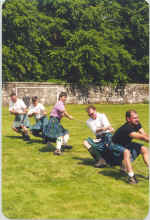 The march continued
on to Kirkhill where we heard more history then to the mansion house for
the unveiling of a plaque with names of donors to the fund for the
restoration of the walls. We then had lunch under a marquee in the walled
garden while a pipe band entertained us. After lunch the reenactors put on
a display then we had Scottish games with the tug of war being the main
event. That night after dinner there was a tartan ball at the hotel. The march continued
on to Kirkhill where we heard more history then to the mansion house for
the unveiling of a plaque with names of donors to the fund for the
restoration of the walls. We then had lunch under a marquee in the walled
garden while a pipe band entertained us. After lunch the reenactors put on
a display then we had Scottish games with the tug of war being the main
event. That night after dinner there was a tartan ball at the hotel.
On Sunday morning the
tartan-clad clan attended church together at the Carmichael Church. Our
Chief and his Lady read the lessons and after the sermon my cousin, Kathy
Gambill, sang "I Am A Servant." There was then a marriage
blessing ceremony for two couples of the clan. After the service we were
returned to either the Glasgow or Edinburgh airport by van or coach and
the Gathering was concluded. Several of us chose to stay another night
rather than take a late flight back to the US. We spent the night at the
Blair Villa Guest House in Glasgow, a bed-and-breakfast owned by Alan and
Ellen Carmichael. 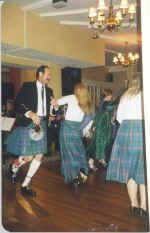 We found them on the Internet and had never met before,
but by the time we left the next morning, we were "cousins"
indeed. We found them on the Internet and had never met before,
but by the time we left the next morning, we were "cousins"
indeed.
We had been in Scotland for
19 days, but there were tears in our eyes as we boarded our flight the
next morning. This country is so beautiful! There is so much history in a
small area. There are lovely sunny and warm days and some rainy and chilly
days. It is all the experience of Scotland. If you go with your heart and
your eyes open, you will be greatly blessed and enriched by the
experience. You must see Scotland! This country wraps itself around you,
squeezes your heart, and will easily pull you back.
Jeanette
Simpson
(Note: If you click on the
pictures on this page larger images will be shown) |
